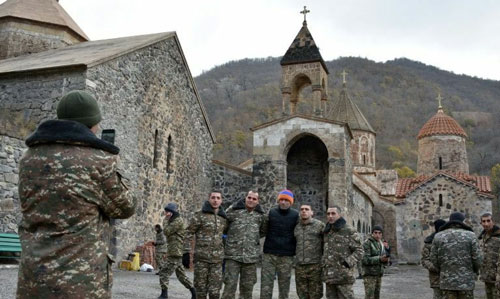Kalbajar
Azerbaijani soldiers and military trucks rolled into the district of Kalbajar, reclaiming the second of three regions Armenia is handing back under a deal that ended weeks of fighting.
Images released by Azerbaijan’s defence ministry showed troops deploying into the district overnight, some scanning for landmines on snow-covered roads.
The district is among those being handed back by Armenia after it agreed to a peace deal ending six weeks of clashes over the disputed Nagorno-Karabakh region.
Kalbajar, wedged between Karabakh and the territory of Armenia, was initially scheduled for handover on November 15 but Azerbaijan pushed back the deadline for humanitarian reasons.
Armenia agreed to hand back three districts around Karabakh — Aghdam, Kalbajar and Lachin — as part of the deal that stopped an Azerbaijani offensive that had reclaimed swathes of territory lost to Armenian separatists in a 1990s war.
Aghdam was ceded on November 20 and Lachin is to be handed over by December 1. Near the village of Cherektar on the edges of Kalbajar, Armenian soldiers were setting up a checkpoint with stacks of tyres blocking the road.
Holding a Kalashnikov rifle and with a white cross drawn on the front of his camouflage uniform, 20-year-old soldier Armen Shakhnazaryan said it was a shame for Armenia to lose the district.
“We have a lot of churches here,” Shakhnazaryan told AFP. “Our ancestors, our elders and our friends are buried here.”
In a televised address on Wednesday, Azerbaijan’s President Ilham Aliyev congratulated his people, saying Kalbajar had been “liberated”.
He said historic monuments in the district including churches and mosques were considered “historical treasures” by mainly Muslim Azerbaijan and would be preserved.
Azerbaijanis who fled the region nearly 30 years ago are expected to return as Armenians left en masse.
In the days before the handover, Kalbajar residents packed all they could take, determined to leave nothing for their longtime foes.
Locals collected electric cables, loaded parts of a hydroelectric power station into a truck and even cut down trees to take with them as they left.
But 22-year-old Gevorg Vanyan — who works at a gas station in the village of Getavan in a district bordering Kalbajar — said he will not leave even if it was “very dangerous” to stay.
“Never in my life could I imagine that life could change like this… But we have lived here and will live here,” Vanyan told AFP.
Clashes between the ex-Soviet rivals over Nagorno-Karabakh broke out in late September, reigniting a long-simmering conflict over the mountainous region.
The ethnic Armenian enclave broke away from Azerbaijani control in the 1990s war and declared independence, though this was never internationally recognised.
The peace deal was reached after Azerbaijan’s military overwhelmed Armenian separatist forces and threatened to advance on Karabakh’s main city Stepanakert.
Under the agreement, Armenia is losing control of seven districts seized during the post-Soviet war in the 1990s, which killed 30,000 people and displaced many Azerbaijanis that used to live there.
The separatists are retaining control over most of Karabakh’s Soviet-era territory and some 2,000 Russian peacekeepers have deployed along frontline areas and to protect the Lachin corridor, which connects Karabakh with Armenia.
Other Armenians have meanwhile been returning to Karabakh itself. Russia said on Wednesday it had helped more than 15,000 people to return from Armenia after they had fled the fighting, which left thousands dead including more than 100 civilians.
Moscow’s role in halting the fighting has stolen the spotlight from France and the United States, who together with Russia form the so-called Minsk Group of negotiators that brokered an unstable ceasefire in the 1990s.
The three countries attempted three separate ceasefires during the recent fighting, all of which collapsed as Armenia and Azerbaijan accused each other of violations.
Azerbaijan’s prosecutor general meanwhile said Wednesday the country was investigating allegations of war crimes against both sides. Videos circulated on social media during the fighting that allegedly showed executions of Armenian prisoners of war by Azerbaijani troops and Armenian soldiers defiling the bodies of Azerbaijani servicemen.
“There are many fake videos. But we must say frankly that there also are videos which could be authentic,” Kamran Aliyev told AFP in an interview. “Azerbaijan is a law-based state and we are reacting to such facts.”—AFP









